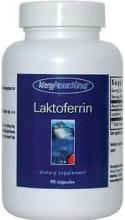Lactoferrin - 350 MG - 90 VCP
Lactoferrin exerts its antibacterial activity in two ways. The first mechanism is by depriving the micro-organisms from iron needed for growth; the second mechanism is by direct binding to the microbial membrane, which alters the membrane permeability and leads to death of the organism.
It is well recognized that the gut flora of breast-fed infants, in contrast to infant formula-fed infants, is much richer in bifidobacteria and lactobacilli. Lactoferrin in conjunction with other factors in milk likely contributes to this favorable microbial ecosystem in the gut.
Tests showed that lactoferrin could reduce the severity and duration of enteric infections. Rudney et al. demonstrated that lactoferrin, by binding to oral Streptococci, had a positive influence on the microbial ecology of the tooth surface.
Oral administration of lactoferrin to rainbow trout increased survival rate when challenged with Vibrio.
Lactoferrin's affinity for iron..
Lactoferrin's affinity for iron exceeds that of transferrin in the presence of the acid environment characteristic of inflamed tissues. Lactoferrin exhibits bacteriostatic properties. It would seem that lactoferrin is delivered to areas of inflammation by polymorphnuclear leukocyte. Once there, it serves to limit the availability of iron in invading pathogens. Lactoferrin joins into the coordinated host response to stress. The purpose of this response is to prevent invading pathogens from utilizing host iron supplies for multiplication.
Iron deprivation..
Most micro-organisms need iron for growth. Lactoferrin therefore has the potential to inhibit the growth of bacteria and even kill them by depriving them of iron.


